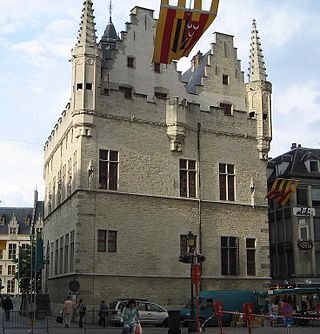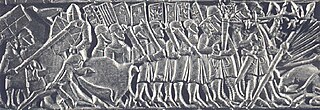Related Research Articles

Transport in Belgium is facilitated with well-developed road, air, rail and water networks. The rail network has 2,950 km (1,830 mi) of electrified tracks. There are 118,414 km (73,579 mi) of roads, among which there are 1,747 km (1,086 mi) of motorways, 13,892 km (8,632 mi) of main roads and 102,775 km (63,861 mi) of other paved roads. There is also a well-developed urban rail network in Brussels, Antwerp, Ghent and Charleroi. The ports of Antwerp and Bruges-Zeebrugge are two of the biggest seaports in Europe. Brussels Airport is Belgium's biggest airport.

Flanders is the Dutch-speaking northern portion of Belgium and one of the communities, regions and language areas of Belgium. However, there are several overlapping definitions, including ones related to culture, language, politics, and history, and sometimes involving neighbouring countries. The demonym associated with Flanders is Fleming, while the corresponding adjective is Flemish, which can also refer to the collective of Dutch dialects spoken in that area, or more generally the Belgian variant of Standard Dutch.

The Seventeen Provinces were the Imperial states of the Habsburg Netherlands in the 16th century. They roughly covered the Low Countries, i.e., what is now the Netherlands, Belgium, Luxembourg, and most of the French departments of Nord and Pas-de-Calais (Artois). Also within this area were semi-independent fiefdoms, mainly ecclesiastical ones, such as Liège, Cambrai and Stavelot-Malmedy.

Joan, often called Joan of Constantinople, ruled as Countess of Flanders and Hainaut from 1205 until her death. She was the elder daughter of Baldwin IX, Count of Flanders and Hainaut, and Marie of Champagne.

The Flemish peasant revolt of 1323–1328, sometimes referred to as the Flemish Coast uprising in historical writing, was a popular revolt in late medieval Europe. Beginning as a series of scattered rural riots in late 1323, peasant insurrection escalated into a full-scale rebellion that dominated public affairs in Flanders for nearly five years until 1328. The uprising in Flanders was caused by excessive taxations levied by the Count of Flanders Louis I and by his pro-French policies. The insurrection had urban leaders and rural factions, which took over most of Flanders by 1325.

In the history of the Low Countries, the Burgundian Netherlands or the Burgundian Age is the period between 1384 and 1482, during which a growing part of the Low Countries was ruled by the Dukes of Burgundy. Within their Burgundian State, which itself belonged partly to the Holy Roman Empire and partly to the Kingdom of France, the dukes united these lowlands into a political union that went beyond a personal union as it gained central institutions for the first time.

Louis II, also known as Louis of Male, a member of the House of Dampierre, was Count of Flanders, Count of Nevers, and Count of Rethel from 1346 to 1384, and also Count of Artois and Count of Burgundy from 1382 until his death. He was the son of Count Louis I of Flanders and the Countess of Burgundy and Artois, Margaret I of Burgundy, the youngest daughter of the King of France, Philip V the Tall.

The Council of Troubles was the special tribunal instituted on 9 September 1567 by Fernando Álvarez de Toledo, 3rd Duke of Alba, governor-general of the Habsburg Netherlands on the orders of Philip II of Spain to punish the ringleaders of the recent political and religious troubles in the Netherlands. Due to the many death sentences pronounced by the tribunal, it also became known as the Council of Blood. The tribunal would be abolished by Alba's successor Luis de Zúñiga y Requesens on 7 June 1574 in exchange for a subsidy from the States-General of the Netherlands, but in practice it remained in session until the popular revolution in Brussels of the summer of 1576.

A Joyous Entry is a ceremonial event marking the entry into a city by a monarch, prince, duke, or governor in parts of modern-day Belgium. Originating in the Middle Ages, it generally coincided with the affirmation or extension of the city's civic rights and privileges.

From the 15th century onwards, the Great Council of the Netherlands at Mechelen was the highest court in the Burgundian Netherlands. It was responsible for the Dutch-, French- and German-speaking areas. In Luxembourgish the phrase "mir ginn op Mechelen" still means playing one's last trump card. The Grote Raad first sat in the Schepenhuis in Mechelen then, from 1616, in the (old) palace of Margaretha of Austria on Keizerstraat.

St Martin's Church, also called St Martin's Cathedral, is a church and former cathedral in the Belgian city of Ypres. It was a cathedral and the seat of the former diocese of Ypres from 1561 to 1801, and is still commonly referred to as such. At 102 metres (335 ft) tall, it is among the tallest buildings in Belgium.

Jean Grusset dict Richardot, knight was a statesman and diplomat from the Franche-Comté, who held high political office during the Dutch Revolt and played an important role in restoring Habsburg rule in the Southern Netherlands.

The Franco-Flemish War was a conflict between the Kingdom of France and the County of Flanders between 1297 and 1305.

The County of Flanders was one of the most powerful political entities in the medieval Low Countries, located on the North Sea coast of what is now Belgium. Unlike its neighbours, such as the counties of Brabant and Hainaut, it was within the territory of the Kingdom of France. The counts of Flanders held the most northerly part of the kingdom, and were among the original twelve peers of France. For centuries, the economic activity of the Flemish cities, such as Ghent, Bruges and Ypres, made Flanders one of the most affluent regions in Europe, and also gave them strong international connections to trading partners.

Remi Drieux, Latinized Remigius Driutius (1519–1594) was the first bishop of Leeuwarden and the second bishop of Bruges.
Martin Bauwens of Riethoven or Martinus Rythovius was a Catholic theologian and the first Bishop of Ypres. He was a figure of some spiritual and political significance during the early decades of the Dutch Revolt.

Filips Wielant (1441/2–1520) was a magistrate and legal theorist in the Burgundian Netherlands, and a participant in the Flemish revolts against Maximilian of Austria.

The Burgundian State is a concept coined by historians to describe the vast complex of territories that is also referred to as Valois Burgundy.
Felix Guillaume Antoine Brenart (1720–1794) was the last bishop of Bruges prior to the suppression of the diocese in the French period.
References
- ↑ Victor Gaillard, L'audience du comte: Origine du Conseil de Flandre (1854).
- 1 2 3 4 5 6 7 8 Jean Léonard Henri Ganser, Le Conseil de Flandres (Ghent, 1846).
- ↑ Patricia Carson, The Fair Face of Flanders (revised edition, Tielt, 2001), p. 113.
- ↑ Jos Monballyu, Six Centuries of Criminal Law: History of Criminal Law in the Southern Netherlands and Belgium, 1400–2000 (Leiden and Boston, 2014), p. 133.
- ↑ also Chancellor of Brabant from 1407.
- ↑ Andries Colin resigned but came back in 1477 for 2 more years.
- ↑ also: Reniger, Reingher, Reyenger